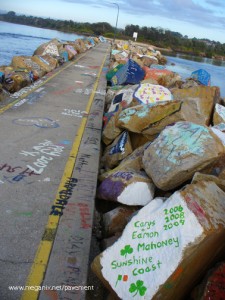 At Nambucca Heads, on the NSW mid north coast, one of the cultural attractions is graffiti – of the mum-and-dad-and-the-kids variety – applied in house paint to the twin breakwaters called the ‘Vee-Wall’. It all started in the 1960s and now photographs of the wall are featured on postcards and tourist brochures
At Nambucca Heads, on the NSW mid north coast, one of the cultural attractions is graffiti – of the mum-and-dad-and-the-kids variety – applied in house paint to the twin breakwaters called the ‘Vee-Wall’. It all started in the 1960s and now photographs of the wall are featured on postcards and tourist brochures
Read the messages and you will find stories of people who have enjoyed their holiday at Nambucca and want others to know it. Honeymooners who have returned to find they still love the place (and each other). Families who come back year after year, adding the names of new babies to the family rock. Overseas tourists who want to leave their mark on Australia. Teenagers who reveal their current crushes. Names, dates, tributes to Nambucca and thanks to God are all here, many decorated with pictures of family members or the fish they caught.
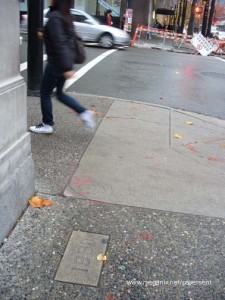 How do I know when the sidewalks of Vancouver were last paved? Easy. The year is impressed into the concrete. Near one of these imprints I found an impromptu wet cement drawing. This piece of pavement graffiti was the first one I photographed after arriving in Vancouver for a conference. It reflected how I felt after the 14-hour flight from Sydney.
How do I know when the sidewalks of Vancouver were last paved? Easy. The year is impressed into the concrete. Near one of these imprints I found an impromptu wet cement drawing. This piece of pavement graffiti was the first one I photographed after arriving in Vancouver for a conference. It reflected how I felt after the 14-hour flight from Sydney.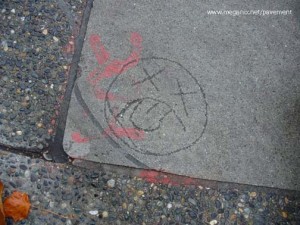
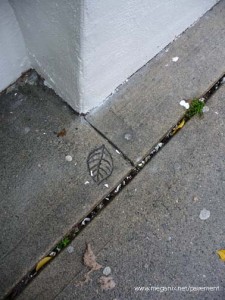 How quaint, I thought. Someone has etched an autumn leaf in wet cement on the sidewalk. Then I noticed another, and then a whole slew of them under an almost bare street tree.
How quaint, I thought. Someone has etched an autumn leaf in wet cement on the sidewalk. Then I noticed another, and then a whole slew of them under an almost bare street tree.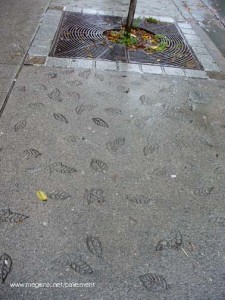 Vancouver has many examples of street art, most of it official, some of it unofficial (though, as you would expect, graffiti mostly occurs at the fringes of Downtown, not in the centre).
Vancouver has many examples of street art, most of it official, some of it unofficial (though, as you would expect, graffiti mostly occurs at the fringes of Downtown, not in the centre).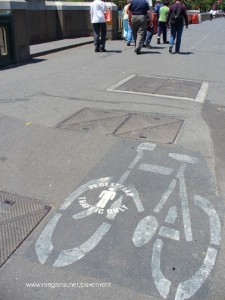 There is an ongoing battle between cyclists and just about everyone else – motorists don’t want them on the roads, pedestrians (like me) don’t want them on the footpaths. The issue is a perennial filler for Sydney newspapers and has flared again this week in news stories, opinion pieces and letters to the editor.
There is an ongoing battle between cyclists and just about everyone else – motorists don’t want them on the roads, pedestrians (like me) don’t want them on the footpaths. The issue is a perennial filler for Sydney newspapers and has flared again this week in news stories, opinion pieces and letters to the editor.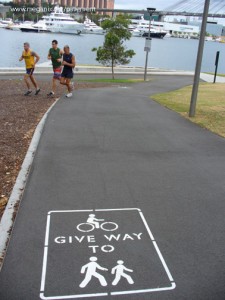 Almost every sign, symbol, graphic and graffiti marked on the roads and sidewalks is a claim for territory. The two examples photographed for today’s blog record instances where pedestrians have had a victory over cyclists, officially at least, and probably only temporarily. The ineptly obliterated bicycle symbol overpainted with a ‘Pedestrian traffic only’ stencil was on the bridge at the corner of St Kilda Road and Flinders Street in Melbourne in 2005. The ‘Give way’ stencils appeared in parks in the City of Sydney towards the end of 2008 after many complaints from pedestrian park-users.
Almost every sign, symbol, graphic and graffiti marked on the roads and sidewalks is a claim for territory. The two examples photographed for today’s blog record instances where pedestrians have had a victory over cyclists, officially at least, and probably only temporarily. The ineptly obliterated bicycle symbol overpainted with a ‘Pedestrian traffic only’ stencil was on the bridge at the corner of St Kilda Road and Flinders Street in Melbourne in 2005. The ‘Give way’ stencils appeared in parks in the City of Sydney towards the end of 2008 after many complaints from pedestrian park-users.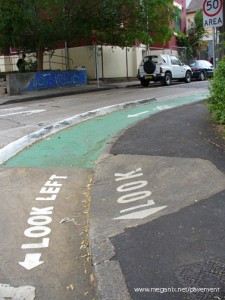

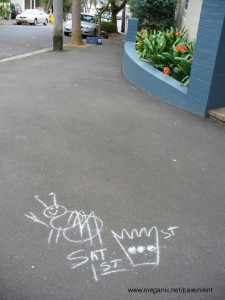 I figured this sign was not meant for me. Some private joke or invitation, but still I was intrigued. Sat 1st? Yes, I got that – the previous Saturday was August 1st. Queen Street? King Street? Crown Street? No streets of that name anywhere near this spot, the corner of Ross and Hereford Streets, Forest Lodge (Glebe). And as for the upbeat insect? Â No idea.
I figured this sign was not meant for me. Some private joke or invitation, but still I was intrigued. Sat 1st? Yes, I got that – the previous Saturday was August 1st. Queen Street? King Street? Crown Street? No streets of that name anywhere near this spot, the corner of Ross and Hereford Streets, Forest Lodge (Glebe). And as for the upbeat insect? Â No idea.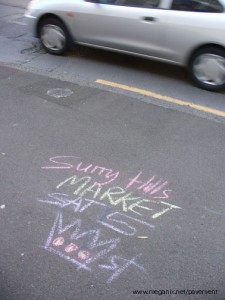
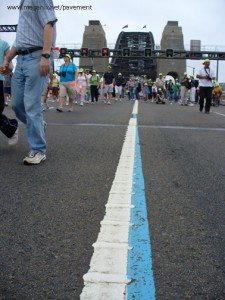 The blue ribbon event of the Sydney 2000 Olympic Games was the marathon, whose 42 km route wound past Sydney’s most recognizable icons and through some of its most telegenic suburbs. A few sections of the blue marathon line have been left in place around Sydney, but only where they do not constitute a traffic hazard.
The blue ribbon event of the Sydney 2000 Olympic Games was the marathon, whose 42 km route wound past Sydney’s most recognizable icons and through some of its most telegenic suburbs. A few sections of the blue marathon line have been left in place around Sydney, but only where they do not constitute a traffic hazard.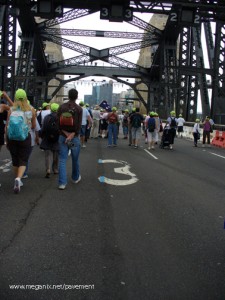
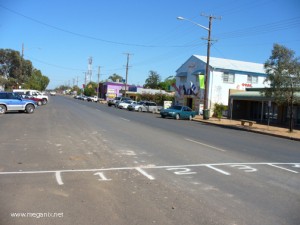 After the crowds have cleared the traces remain. The numbers on the road mark the starting line for the annual Great Goat Race in the main street of Lightning Ridge, NSW. The photograph was taken the day after, on Easter Sunday 2006.
After the crowds have cleared the traces remain. The numbers on the road mark the starting line for the annual Great Goat Race in the main street of Lightning Ridge, NSW. The photograph was taken the day after, on Easter Sunday 2006.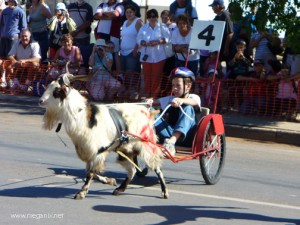
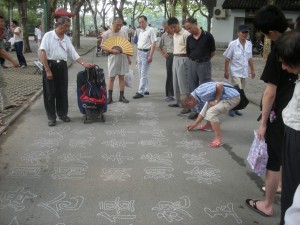 I love Lu Xun Park. It’s in Hongkou, Shanghai, and is my most favourite place on earth at the moment. Everything happens here – there is dance, tai chi, singing, talking, and sitting. Lovely, to me, and I can’t even speak Chinese.
I love Lu Xun Park. It’s in Hongkou, Shanghai, and is my most favourite place on earth at the moment. Everything happens here – there is dance, tai chi, singing, talking, and sitting. Lovely, to me, and I can’t even speak Chinese.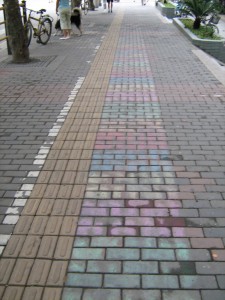 Sometimes migrant workers write their story on the ground asking for help. They come to the city from rural areas and often have trouble finding work. The second photograph was taken after rain had blurred a woman’s story about her current living situation.
Sometimes migrant workers write their story on the ground asking for help. They come to the city from rural areas and often have trouble finding work. The second photograph was taken after rain had blurred a woman’s story about her current living situation.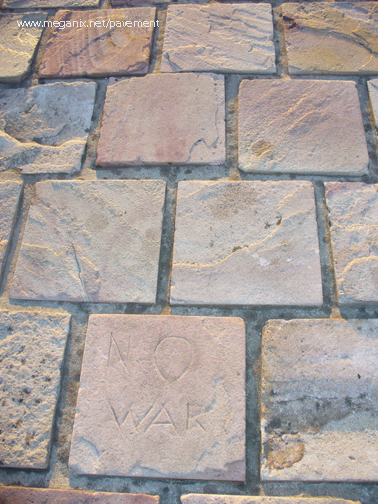 At Federation Square in Melbourne Nearamnew is a public artwork that incorporates the cobblestone paving. According to the
At Federation Square in Melbourne Nearamnew is a public artwork that incorporates the cobblestone paving. According to the